Editor’s Note: This is Part 3 of an "on-site" series about Silversea Cruises’ “Antarctica Bridge” expedition cruises. In this installment, we outline the expedition experience that guests will have on Silver Endeavour. For more, check out Part 1 (Getting There) and Part 2 (Public Venues, Suites and Service).
Nothing can really prepare cruise guests for the dramatic, spectacular natural beauty of Antarctica. Day after day on our recent Silversea Cruises’ Silver Endeavour voyage, Luxury Travel Advisor gazed out in wonder. Nestled at the end of the Earth, Antarctica is truly unlike any place else on Earth. Thanks to almost no hint of civilization during our expedition outings—and with 360-degree views from the top of the ship—that perspective was amplified to the maximum.
Once or twice a day, we and other guests headed out for expeditions via motorized Zodiacs piloted by members of the ship’s expedition team. Many were scenic, discovery cruises, getting up close to wildlife, icebergs or terrain on either islands or the "White Continent" itself. Other outings involved Zodiac transport to a beach landing site and then a "wet landing" ashore. Here, guests walked along pebbly beaches, up rocky slopes and through snowy/icy terrain.
Humpback whales often gathered near the ship or in remote bays. We’d watch amid eerie silence, before hearing their distinctive “blows.” Penguins were simply everywhere. Marine birds flew overhead. Seals lounged on icebergs or popped their heads out of the water, as if to greet us.
In total, Captain Ulf-Peter Lindstrom’s log book showed we visited 15 different spots in Antarctic waters. These ranged from coves, bays and beaches on the "White Continent" to diverse islands along the Antarctic Peninsula and in the Weddell Sea. From start to finish, Silver Endeavour traveled 948 nautical miles roundtrip from Frei Station, King George Island, South Shetland Islands.
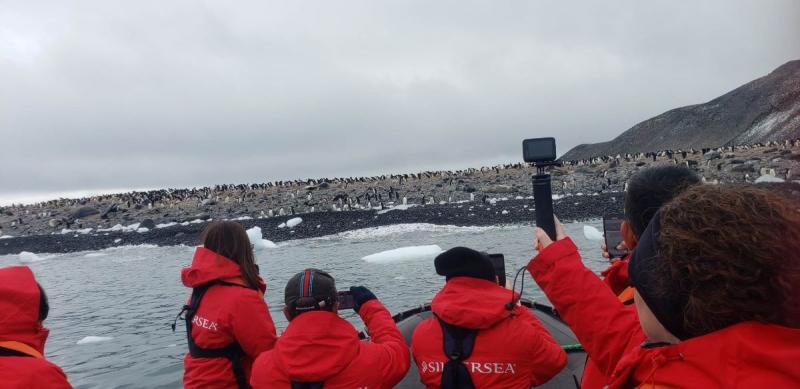
So,here's a first-hand look at the ship's expedition "product" and what we did along the way in "expedition mode."
Penguins Galore
Along the way, we spotted many seals, marine birds and penguins. At Paulet Island, more aptly described as “penguin central,” we gazed at tens of thousands of Adelie Penguins. We watched them either from a Zodiac hovering close to shore or by walking across the island and on the slopes a bit closer to them (but staying the required distance away). Altogether, the isle has more than 100,000 pairs of breeding penguins. The cute, waddling marine birds covered every square inch of land as far as the eye could see. In late December, the timing was perfect to spot small gray, fuzzy chicks, nestled under their moms' legs.
What makes an expedition so interesting is that one sees many species. So, we viewed Adelie, Chinstrap, Emperor and Gentoo penguins throughout our cruise.
The expedition team nicely points out to guests which species they're viewing and gives “hints” for spotting them. For example, Gentoo Penguins are easily recognized by the wide, white stripe across extending as a bonnet across their heads and a bright orange bill.
When in the water, Adelie Penguins are incredibly fast—swimming, then leaping out of the water, diving back down, swimming and leaping, and doing that over and over again. They definitely were speed demons.
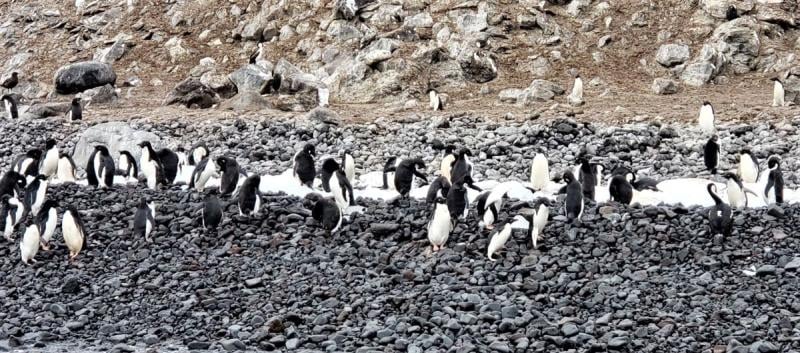
Lack of Civilization,
Once we left King George Island, South Shetland Islands, we only sited a few small red, uninhabited buildings belonging to the Argentinian research station. But, otherwise, that was all we saw of civilization ashore the entire cruise. Of course, each sailing is different.
Despite the icy, snowy look of each spot in Antarctica, most had a distinct look and feel. We wondered before arriving in Antarctica if we’d feel the scenery was "repetitive." The reality? Not from our perspective, as we sailed from Neko Harbour to Cuverville Island, from Cierva Cove to Brown Bluff, Half Moon Island and beyond.
In fact, when Facebook contacts who traveled on later voyages posted their social media posts with photos, we said, “wait, we’ve definitely seen that specific spot."
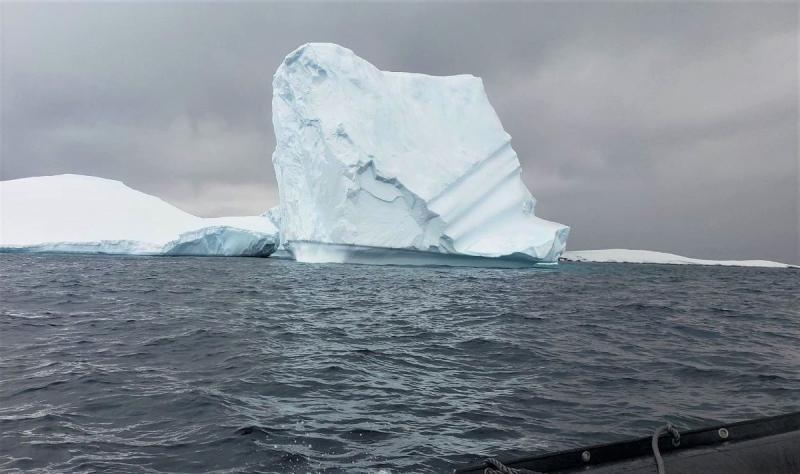
Along the way, the PC6 polar-class Silver Endeavour navigated through ice floes and around icebergs. Some icebergs were “cathedral-sized" with even larger, glacial-blue icy bottoms visible beneath the clear water. For some guests, initial thoughts of "Titanic" surfaced, but most guests felt comfortable and safe throughout the trip, thanks to modern technology and a skilled bridge team.
But the icebergs and ice floes created "aura." Also, it was simply magical being in a Zodiac on Christmas Day while it was snowing.
The Weddell Sea
Most notably, we sailed into the Weddell Sea. That's not possible on every Antarctica Bridge voyage, but it was doable for our bit-longer cruise.
What’s special about the Weddell Sea? In 1914-1916, Sir Ernest Shackleton and the crew of Endurance were marooned in Antarctica. It's an incredible tale of disaster, survival and, ultimately, rescue. Silver Endeavour's guests loved discussing that voyage and reading books about it including Shackleton’s own book, “South!”
Shackleton's ship was crushed by the pack ice and sank. But in 2022, Endurance was discovered—amazingly well-preserved under the sea with the ship's helm and nameplate clearly visible. That's because cold Antarctic waters prevented organisms from consuming the ship.
The Expedition Unfolds
So, here's a look at the nitty-gritty details of how Silver Endeavour's expedition experience unfolds.
On embarkation day, guests—already decked out in their red Silversea parkas, waterproof pants and boots—depart the line's Antarctic Air BAE146 charter flight at Prince George Island, South Shetland Islands. They quickly board the line's shuttle or van for a drive along a gravel road to a pebbled beach. We'd estimate it's about a mile or so.
On the beach, guests don a life jacket, turn over any handluggage to expedition team members and are assisted in sitting on the side of their Zodiac and swinging their feet inside. While seated, they scoot to the end of the Zodiac (something done on all expeditions). Their backpacks can be placed between their feet on the Zodiac’s floor. Other carry-ons and the guest's bag are transported in separate Zodiacs.
From the beach it’s just a five- to 10-minute Zodiac ride to Silver Endeavour. As the small rubberized craft approaches the ship, expedition team or other crew members are waiting in a lower-level, open section of the ship. There's no platform or gangway.
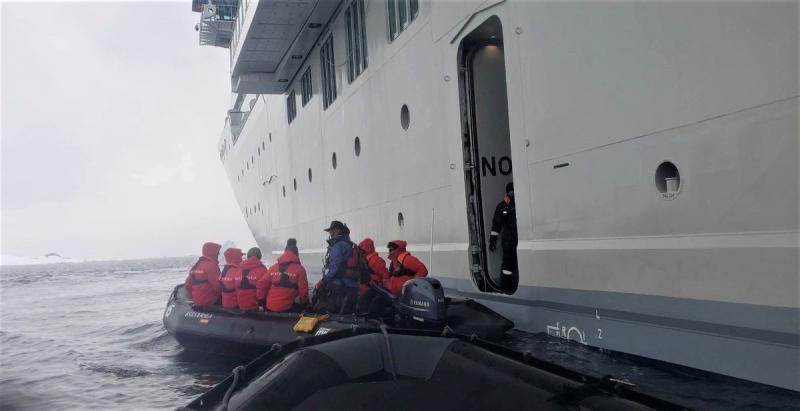
Ropes are thrown and soon one Zodiac at a time is secured alongside the ship. To assist guests making the transfer to the ship, expedition team and crew members provide their arms for balance. Two moveable steps are helpful for those (such as this reporter) who are short and can't step up so far. Our knees also appreciated that assistance.
The Mud Room
Once aboard, guests walk up a short ramp up to the ship’s Mud Room. Before getting there, guests traipse through a wet solution that sanitizes and cleans their boots. Debris is removed, and if additional assistance is needed, the expedition team is ready.
Each guest has an assigned Mud Room locker; it has the same number as their suite. Here, they place their life jacket, where it remains until their next expedition outing. Using the Mud Room's bench seating, guests remove their boots. Ours proved stubborn, so we grabbed a small, handy, slanted platform, which helped immensely in getting the needed leverage to pull them off. Next, guests place their wet boots onto long slender rods in a drying space adjacent to the lockers. Gloves can also go in the same spot to dry.
One Mud Room observation? Despite sailing on multiple expedition ships over the years, we felt this was one of the cleanest such rooms we'd ever seen.
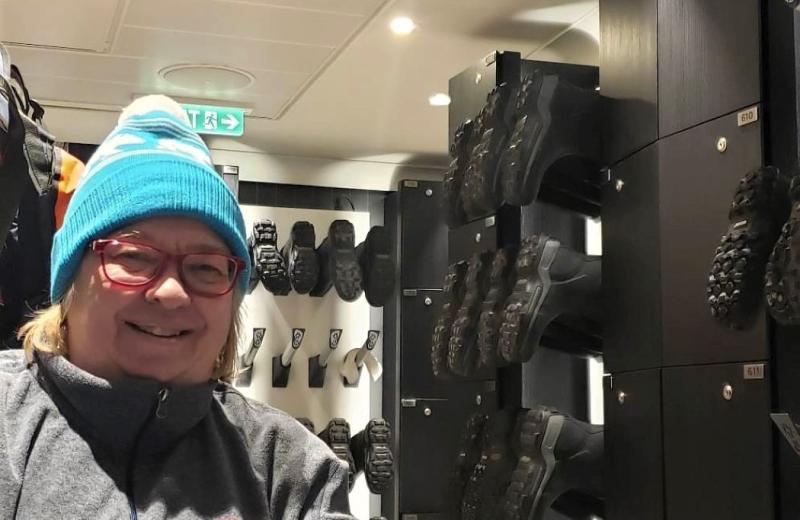
Earlier in the day, on the charter flight to King George Island, guests had placed their regular shoes in their backpacks. So, once in the Mud Room, they put their shoes back on and then head for a podium where a crew member checks them off a passenger manifest.
A hospitality crew member is also present to say "welcome aboard" and offer flutes of Champagne and other drinks. Guests are then escorted by a hospitality crew member to the fifth-floor Reception area for check-in. That accomplished and with key cards in hand, guests are ready to see their suites.
Entering No. 630, our Premium Veranda Suite, we discovered a nice "drying closet" adjacent to the entry door. It was perfect for airing out our wet/damp parka, pants and hat. Important to note: It's separate from the suite’s walk-in closet.
Briefings and Recaps
Shortly after boarding, we strolled to the Explorer Lounge. Every day, at about 6:15 p.m. or so, the ship’s expedition team leader and other team members do two things. First, they recap the day’s expedition outings, how things went, what wildlife species were spotted and so on. Second, they provide a briefing for the “explorers” about what to expect for the next day's activities.
We loved this recap experience, a nightly tradition in expedition cruising. The lounge's aura and the discussions themselves are warm and welcoming. Bar servers circulate with light bites and drinks. Behind the stage, three large LED screens display colorful photos of penguins, seals, whales, icebergs and guest activities on Zodiacs and ashore.
The recap also creates a shipboard camaraderie among guests—people who feel that they're sharing something special with newfound friends from across the globe. On our cruise, guests hailed from 37 nations: From the U.S. to Malaysia, Canada, China, Australia, the United Kingdom, Italy and Poland, among other countries.
After one day's Zodiac outing, during the recap that evening, one guest proactively came over to me and offered to share her seal photo; she knew I couldn't get the shot earlier given the angle of where I was sitting on the Zodiac. On another day, a family from China and New York struck up a conversation and we became great friends throughout the cruise.
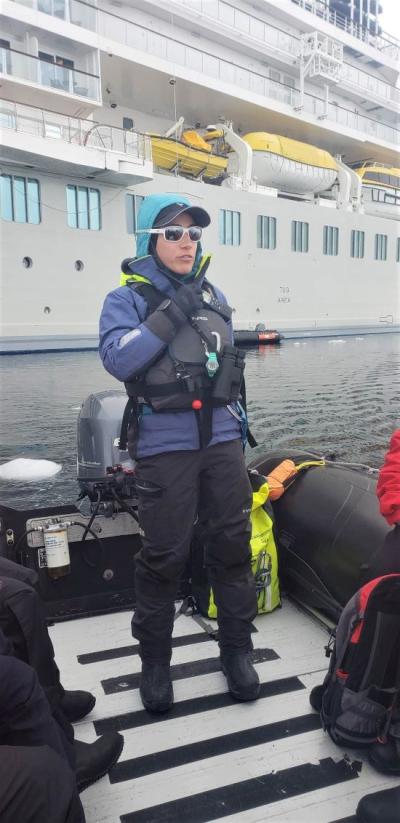
Zodiac. (Photo by Susan J. Young)
Regulations for Antarctica Travel
During the embarkation day briefing, the expedition leader also introduces the ship's expedition team and explains how things will go over the course of the cruise. He or she explains all the strict rules and regulations of the International Association of Antarctica Tour Operators (IAATO), of which Silversea is a member.
IAATO rules are also discussed at a mandatory briefing guests attend in Santiago or Punta Arenas prior to arrival at King George Island, as we noted in Part 1 of this series, “Getting There.”
Cruise lines that are IAATO members must practice safe and environmentally responsible private-sector travel to Antarctica. Did you know that no two ships are permitted to be in the same cove, harbor or destination (for taking guests ashore to explore) at the same time? It's true.
So, during our nine days in Antarctica, Luxury Travel Advisor only spotted one Hurtigruten ship that passed us in a channel, and another ship far in the distance in a different harbor. Most days we saw no other vessels or any other folks ashore, except people from our ship.
Throughout our cruise, our expedition leader frequently used the IAATO member site to make reservations for the spots we hoped to visit. In Antarctica, guests should be aware that weather and sea conditions totally impact the ship's route and distance it can travel on any particular day. So, routes can change often and rapidly.
In one case when we headed for an island in the Weddell Sea, we learned that the ship slot for that destination had been previously unavailable. But the expedition leader kept checking on it day after day, and into the wee hours of the morning. Finally, that slot was released by another ship, so she scooped it up for Silver Endeavour.
Following the Rules
Certainly, on the ship, Silversea delivers an ultra-luxury experience with plenty of savory guest choices in dining, relaxation, spa services, fitness activities and so on. Clients get up, and enjoy the spaces and dining on their own schedule, and the ship has 24-hour room service. So, there's much flexibility.
However, the Antarctic expedition experience itself for all lines and all vessels is highly regulated. So, advisors should be aware that an Antarctica cruise, while a fabulous experience for many travelers, probably isn't a good choice for clients who hate structure and rules.
For example, in the "White Continent," guests aren't permitted to go ashore on their own; they're always accompanied by trained expedition team members. There are no docks for cruise ships. All transit to/from Silver Endeavour is via Zodiac. IAATO rules also require that guests can't take food or drinks ashore. Travelers cannot remove anything, man-made or natural, from any Antarctic destination. So, forget the thought of taking home a “souvenir rock," for instance.
As each day begins, Silversea’s expedition team heads ashore to check the landing conditions for Zodiacs. They also look for any conditions that would prohibit a safe expedition there. On one day, the team found extremely thick glacial ice extending from the beach up to the slope above. It wasn't safe for guests. So, we were unable to go ashore at that spot.
But if the landing site looks okay, then the expedition team will use poles to mark a path/hiking route up a slope or along a beach. It's required that guests take these paths/routes when exploring the destination. In other words, don't wander off on your own. The goal is to assure travelers don't slide into a glacial crevice or head into a prohibited eco-area.
In addition, no matter how cute the penguins are, it's a "no no" for guests to touch them. In fact, all those going ashore must stay at least 15 feet away from any wildlife, including penguins, seals and so on.
One humorous tidbit was offered by Silversea’s expedition leader. She told us that if penguins hop into a marked path you're using and the penguin is less than 15 feet away, guests must take a step off the path. Why? Penguins absolutely have the right of way. It seems the smart marine birds appreciate the ease of those already-prepared paths.
She noted that sometimes the penguins simply aren't in any hurry; they'll stop for quite awhile along the path. People simply must wait for them to move. In other words, penguins rule. She also told us to “look behind you” as sometimes the penguins will come right up to guests, but it’s important to just move away.
Color-Coded Group Departures
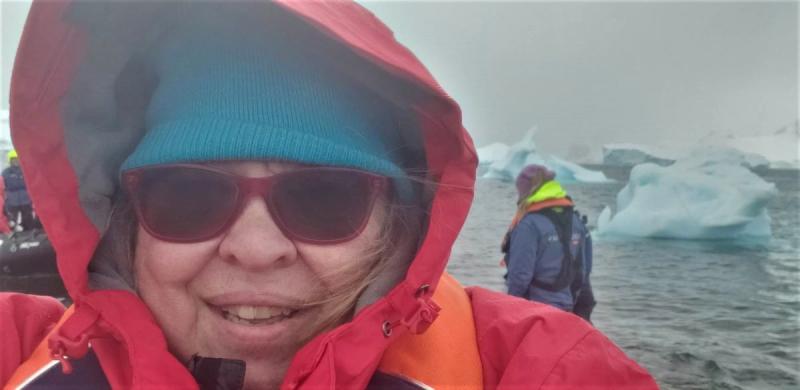
No more than 100 people at a time are allowed ashore in Antarctica. So, Silversea uses color-coded, "timed" departures—splitting the guests aboard Silver Endeavour into four different color groups.
Here's one example: While the Red Group heads out on a Zodiac cruise at 8:30 a.m., at the same time, the Yellow Group boards Zodiacs and make a "wet landing" to explore ashore. Then, the two groups finish those experiences, and flip to the other experience that they haven't done. So,the guests enjoy both a Zodiac cruise to explore and a wet landing and walk ashore.
Then at 10 or 10:30 a.m., for instance, the Green Group and the Blue Group similarly depart on Zodiacs for the same activities on the same type of schedule.
Silversea varies the order of which groups go out first or last each day. So, not every guest has to get up at the crack of dawn every day. On many days, weather permitting, guests will have two separate destination visits—one in the morning, one in the afternoon.
In addition to Zodiacs, Silver Endeavour also carries a fleet of kayaks for use. Guests planning on taking a kayak adventure at any time in the cruise must attend the mandatory briefing offered upon boarding. No make-up briefings are provided.
Expedition Outings
Every morning, usually around 7:30 or 7:45 a.m., the expedition leader greets guests over the ship's PA system, explains the status of the morning's expeditions, and when the color-coded groups are expected to depart.
So, at the appropriate time, guests don their parka, waterproofs pants, gloves and hats, put their phone into the red, water-resistant pouch (a nice perk that comes with the parka) and head to the Mud Room. There, they don their life jacket and boots, and when permitted, they head down the slight ramp and are helped into the Zodiacs.
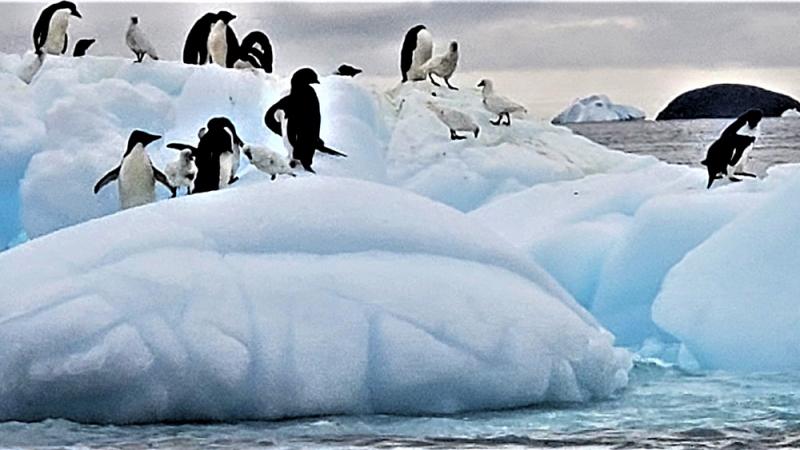
Couple of tips for Zodiac outings? Here’s what we learned after one or two Zodiac cruises:
- Have enough free memory on your cell phone. In Antarctica, it's easy to go crazy snapping photos everywhere. The big draws are whales, seals, penguins, the Zodiac ride itself through iceberg-filled waters, and more. On one occasion, though, our cell phone camera refused to cooperate, stating “out of memory." So, we fiddled to clean out the cache from multiple programs. Don't miss a great, close-up wildlife shot because the phone runs out of memory. Offload previous photos to a laptop or the Cloud before heading out.
- Assure you have a battery charge of 100 percent: We didn’t know this, but were told by the Zodiac pilot and several fellow guests that the cold weather will drain a battery much faster than usual. So, our 60 percent charge, which normally would last for hours, was gone in about a half hour. So, we missed some photo opportunities. Be sure to fully charge your phone before heading out.
- Travel light: If you're bringing a backpack, keep it light. First, you can’t put anything on the ground in Antarctica, so you’ll have to carry it or wear it. And you'll be traversing uneven, often icy/snowy ground. Keeping your balance is critical.
- Use the walking/ski poles: We watched from a Zodiac or the ship as several guests—some using walking/ski poles, others not—took a "dive" into the snowy terrain. One 77-year-old woman fell twice and the expedition team assisted her in getting up. While it didn't appear people were hurt as the surface in many spots was snow-covered, it's prudent to take one or both poles, which may help prevent a fall.
- Bring “waterproof” gloves: We grabbed our regular knit ones at the last minute. They got wet at times due to snowy weather or simply touching wet surfaces on the Zodiac.Silversea had a pre-trip fact sheet about the clothing needed ashore, and we should have read that more thoroughly. Antarctica is not a destination to head out to "on the fly." Research things well in advance.
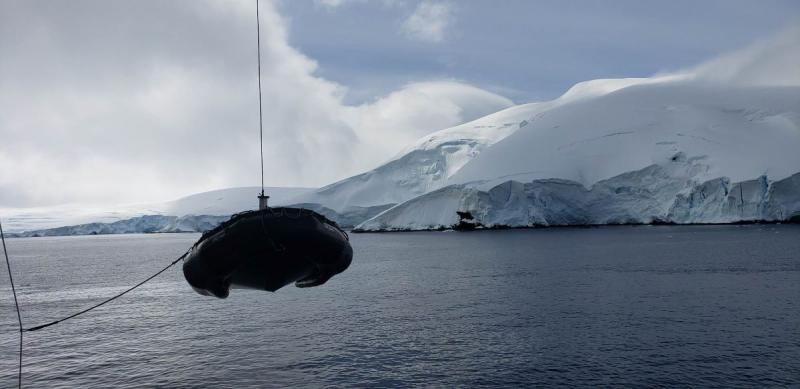
Expedition Talks
During time aboard the ship, guests also head to the Explorer Lounge for enrichment lectures. Often, a lecture was offered at two different times on the same afternoon. Here's a sampling of the talks on our voyage:
- “Whale Ecology and Biology” with Nick Brendenkamp, ornithologist and marine biologist. He discussed the world of whales, their relatives, how they contribute to the marine ecosystem and common misunderstandings about them.
- “The Climate Change in Polar Regions” with Dr. Andre Belem (glaciologist and climatologist). The discussion covered the impact of global warming over Antarctica and the Arctic.
- “An Introduction to the Frozen Continent” with Alexandra Hansen, anthropologist and historian. She explained that Antarctica is a land of extremes—the highest, driest, coldest and windiest continent on Earth .
- “The Evolution of Birds," again with Brendenkamp, dived into the history of birds, their relationship to dinosaurs and some of the giant birds of our past. Penguins were a part of this discussion, of course.
The Polar Plunge
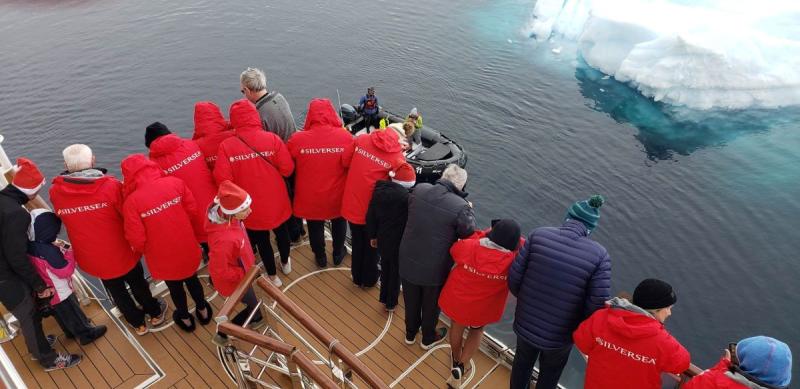
And we'd be remiss by not mentioning "The Polar Plunge," a tradition in polar zones. Guests don swimsuits and jump into the cold water from the ship. They're assisted by crew members and a tether is positioned around their waist for safety. After being given the go-ahead by crew, two guests then jump into the sea simultaneously.
Plungers are only in the frigid water for a minute or less. But they definitely can't wait to get back aboard and tell friends and relatives how "brave" they were.
And yes, no fears, as the Polar Plunge is totally optional. Guests do it or not. It's their choice. On our cruise 82 adventurous souls (out of a total of 145 guests or so) volunteered to take the plunge. Silversea said that was "a record number" for the vessel at that time. No, we didn't do it. But we had fun watching as did other guests. In many ways, it was an entertainment activity for everyone.
Overall Great Experience
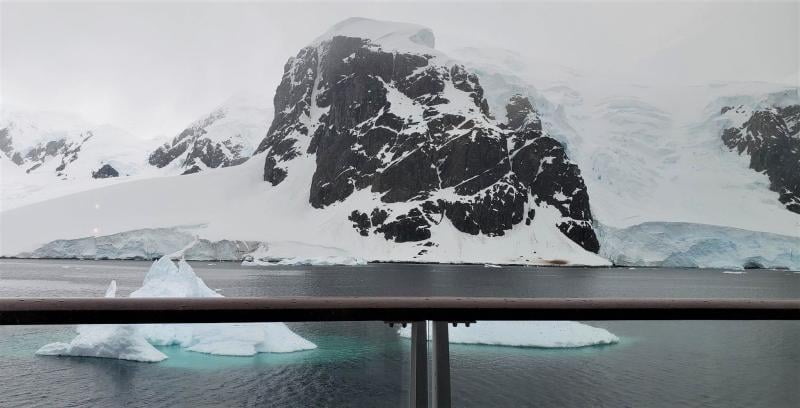
Overall, the Silversea expedition experience was excellent. We felt the expertise, experience and friendliness of the expedition team deserved an "A+" rating. The process flowed very smoothly.
Plus, the expedition leader clearly spent much time poring over the IAATO website schedules for the ship. At times, she stayed up late into the night doing that. That made our expedition experience even better, as she secured "slots" for places we might not have been able to visit otherwise. She truly cared about where we’d go and what we’d see. She sought to maximize the guest experience.
We also felt that the ease of the Zodiac and wet landing processes for guests was good. We liked the expert enrichment lectures, the briefings/recaps, and also the ship’s Library.
The Library is incredibly spacious for a ship this size and offers plenty of nooks and crannies. It also fields a well-curated selection of books and maps. Expedition team members are often based here, too (but not during expedition times). They assist guests, answer questions, suggest reading materials or just chat.
To Be Improved
During the initial days of the cruise, most guests got up early every day to have breakfast or room service before heading out on a morning expedition (and again in the afternoon). That said, as the cruise progressed, some guests preferred to go out on just one expedition a day, often in the afternoon. Some desired to skip a day, too. They were on vacation and some wanted to sleep in once in awhile.
What could be improved? We’d like to see Silversea figure out a way for guests who so desire to block those early-morning announcements into the suites (except in any emergency, of course). Perhaps a switch or some type of other device could be installed to turn them on/off in the suites, based on guest preference.
From our viewpoint, those daily early-morning PA announcements were intrusive. Yet, we thought maybe it was just our perspective. However, on the next-to-last-day of the cruise, the expedition leader started her evening Explorer Lounge briefing about the next morning’s disembarkation procedure by saying, “I’ll be making an announcement about this in the morning." One guest spoke up and said, “please don’t.” The point was made.
Parting Thoughts
Overall, we felt that Silver Endeavour delivered an incredible expedition experience to the end of the Earth. It was the ultimate in ultra-luxury combined with a great expedition product. We also liked the "Antarctica Bridge" sailings for flying directly to King George Island and avoiding the Drake Passage. For others who want to sail the Drake, though, Silver Wind offers voyages from Puerto Williams, Chile.
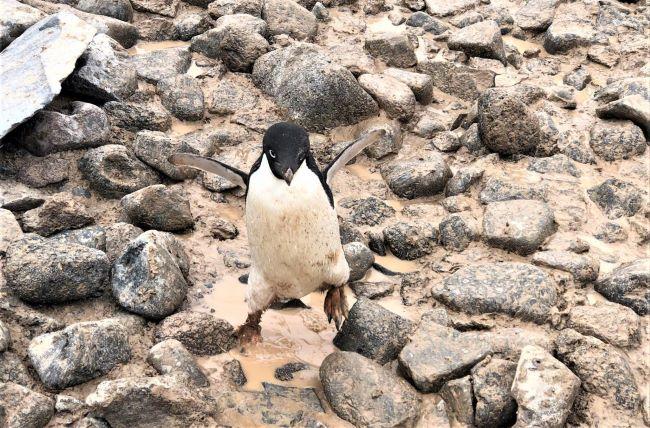
Heading out on adventurous Zodiac rides or wet landings ashore in remote bays, coves and islands never gets old. Nor does gazing at whales, seals, marine birds and particularly cute penguins in the wild. That's truly exhilarating. Simply put, we loved our "bucket list" adventure.
Related Articles
Three Seabourn Venture Cruises Cancelled, Drydock Repairs Needed
Silversea Cuts Steel for Second Nova-Class Ship, Silver Ray
Scenic Unveils New 2024/25 East Antarctica & Ross Sea Voyages